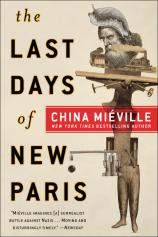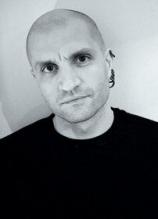The Last Days of New Paris
Review
The Last Days of New Paris
Suppose you’re a reasonably well-educated millennial with a broad grasp of what’s what in the world, but perhaps not especially immersed in any particular discipline. Maybe you’re just embarking on an esthetic and intellectual journey that has yet to reveal those landmarks and detours that will become your life’s most powerful passions. And you’re right here, so you love reading.
You pick up a brand new August 2016 title called THE LAST DAYS OF NEW PARIS by the eccentrically named British author China Miéville because it sounds kind of futuristic and you’re drawn to fiction about alternate possibilities. After all, who doesn’t like the very idea of Paris, the city of light, art, cuisine, architecture and romance?
And then all proverbial hell breaks loose. From the opening pages of Miéville’s serpentine novella about grotesque embattled creatures set loose in a time that fits nowhere, the reader is thrust into a literary hall of mirrors that would make even the most chilling carnival funhouse seem tame.
"Meticulously researched, both historically and esthetically, and penned with an enviably rich descriptive flair, Miéville’s latest exploration of the impossible and implausible is an exciting but exhausting tour de force..."
The story lurches wildly between pre- and post-WWII France, where any adherence to laws of physics and chronology seem to have been switched off, except for the notion that the alternate universe of THE LAST DAYS OF NEW PARIS has been set in motion by its own “big bang,” called the S-Blast (where S stands for Surrealism).
In Miéville’s roiling imagination, this apparent dark-science achievement of the dying Nazi régime has opened a Pandora’s Box of the technologically impossible, trapping a strangely empowered scattering of traumatized humans in its “warp bubble” (only “Star Trek” has the vocabulary to describe it). The mutually distrustful humans, who embody the good, bad and indifferent of our species, not only have to deal with one another’s competing political and personal agendas, but must figure out if the grotesque creatures (“manifs”) they encounter in their shattered world are themselves friend or foe. Often as not, they are fatally wrong.
Now this is the point at which anyone who has not studied the surrealist movement in art (let alone 20th-century political history) will be at a distinct disadvantage, no matter how much you appreciate Miéville’s visceral and innovative prose. Weirdness creates the greatest impact when it savagely departs from the solidly familiar, but how many of us are solidly familiar with the layout of the city of Paris, or the leading names and works of art that comprise the early and mid-20th-century surrealist movement? I must claim ignorance on both counts, except for what I picked up in high school geography and a smattering of university art appreciation seminars. Somehow, I don’t think I’m alone here.
It isn’t that art-coming-to-life per se is such a novelty: fantasy and science fiction, from the undeservedly obscure Lloyd Biggle, to the deservedly popular “classic” and subsequent “Star Trek” series writers, have woven the fine arts into some of the genre’s most compelling moments. And the brief run of “magical realism” that spun out of both genres ventured even further into metaphysical and sensory alternate states. But THE LAST DAYS OF NEW PARIS moves the concept to such lengthy and complex extremes that the engineered confusion of Miéville’s creations (no doubt intended) becomes omnipresent and quite overwhelming.
Meticulously researched, both historically and esthetically, and penned with an enviably rich descriptive flair, Miéville’s latest exploration of the impossible and implausible is an exciting but exhausting tour de force --- a really big, bad Halloween dream from which you wake up thankful for ordinary normal.
Reviewed by Pauline Finch on September 16, 2016





